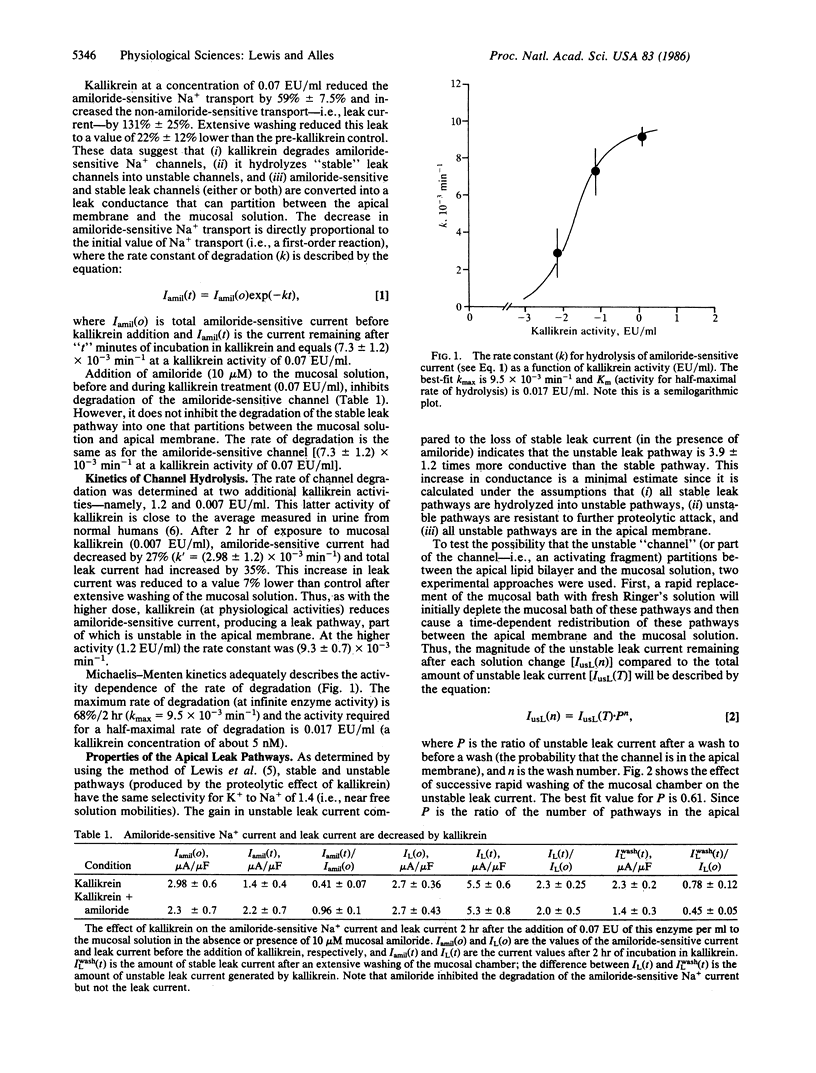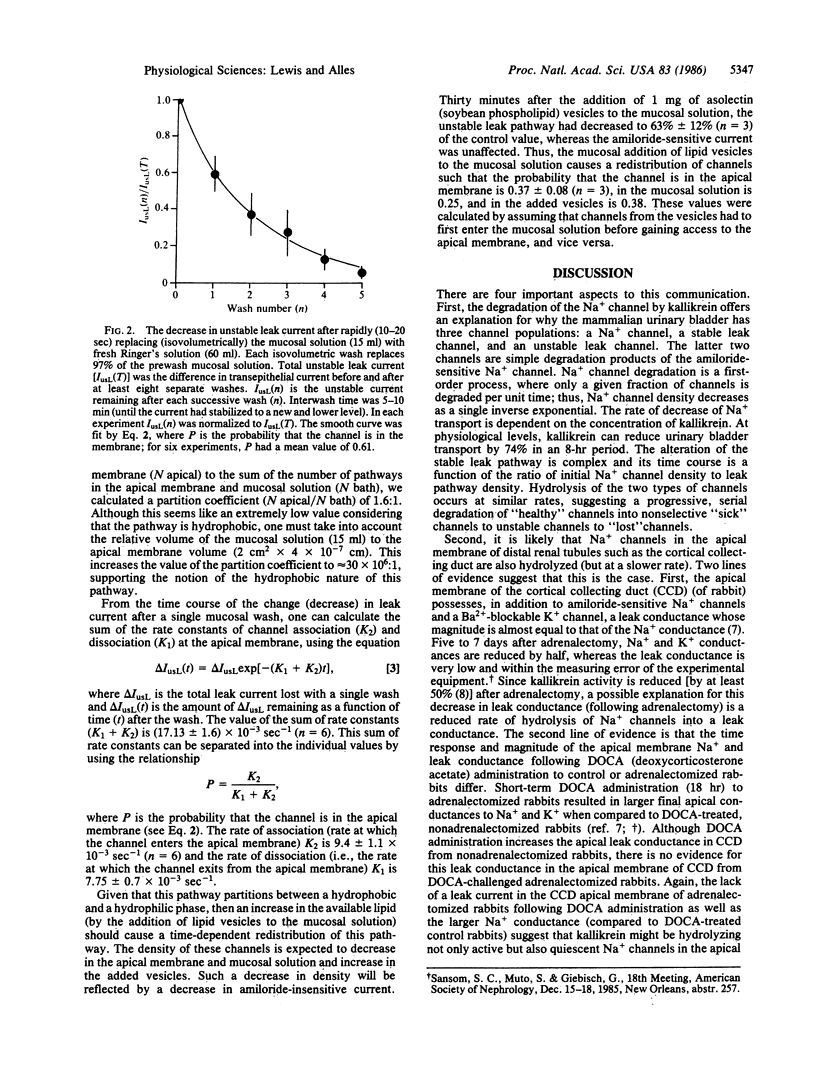Abstract
The apical membrane of the mammalian urinary bladder contains two populations of ionic conductances--one Na+ selective and amiloride blockable, the other cation selective and amiloride insensitive (a leak channel). Addition of kallikrein (an enzyme of unknown function normally found in urine) to the mucosal solution of the mammalian urinary bladder epithelium resulted in the loss (over a 2-hr period) of amiloride-sensitive Na+ current and an increase in the leak current that is amiloride insensitive. The rate of hydrolysis of Na+ channels is a first-order process that is concentration (activity) dependent and described by simple Michaelis-Menten kinetics with a maximum rate of 9.5 X 10(-3) min-1. At the activities measured in human urine, the corresponding rate constant will decrease Na+ channel density by 99.5% in 24 hr. Amiloride protects the amiloride-sensitive Na+ channels from degradation but not the leak pathway. The rate of hydrolysis of the leak pathway as well as the kinetics of hydrolysis are the same as that described for the Na+ channel. Of interest is that the leak pathway is hydrolyzed into a form that seems to partition between the apical membrane and mucosal solution (an unstable leak pathway). These results and previous findings suggest a regulatory role for kallikrein in salt and water homeostasis.
Full text
PDF



Selected References
These references are in PubMed. This may not be the complete list of references from this article.
- Garty H., Edelman I. S. Amiloride-sensitive trypsinization of apical sodium channels. Analysis of hormonal regulation of sodium transport in toad bladder. J Gen Physiol. 1983 Jun;81(6):785–803. doi: 10.1085/jgp.81.6.785. [DOI] [PMC free article] [PubMed] [Google Scholar]
- Lewis S. A. A reinvestigation of the function of the mammalian urinary bladder. Am J Physiol. 1977 Mar;232(3):F187–F195. doi: 10.1152/ajprenal.1977.232.3.F187. [DOI] [PubMed] [Google Scholar]
- Lewis S. A., Ifshin M. S., Loo D. D., Diamond J. M. Studies of sodium channels in rabbit urinary bladder by noise analysis. J Membr Biol. 1984;80(2):135–151. doi: 10.1007/BF01868770. [DOI] [PubMed] [Google Scholar]
- Lewis S. A., Wills N. K. Apical membrane permeability and kinetic properties of the sodium pump in rabbit urinary bladder. J Physiol. 1983 Aug;341:169–184. doi: 10.1113/jphysiol.1983.sp014799. [DOI] [PMC free article] [PubMed] [Google Scholar]
- Lewis S. A., de Moura J. L. Incorporation of cytoplasmic vesicles into apical membrane of mammalian urinary bladder epithelium. Nature. 1982 Jun 24;297(5868):685–688. doi: 10.1038/297685a0. [DOI] [PubMed] [Google Scholar]
- Marchetti J., Imbert-Teboul M., Alhenc-Gelas F., Allegrini J., Menard J., Morel F. Kallikrein along the rabbit microdissected nephron: a micromethod for its measurement. Effect of adrenalectomy and DOCA treatment. Pflugers Arch. 1984 May;401(1):27–33. doi: 10.1007/BF00581529. [DOI] [PubMed] [Google Scholar]
- Margolius H. S., Horwitz D., Pisano J. J., Keiser H. R. Urinary kallikrein excretion in hypertensive man. Relationships to sodium intake and sodium-retaining steroids. Circ Res. 1974 Dec;35(6):820–825. doi: 10.1161/01.res.35.6.820. [DOI] [PubMed] [Google Scholar]
- Margolius H. S. The kallikrein-kinin system and the kidney. Annu Rev Physiol. 1984;46:309–326. doi: 10.1146/annurev.ph.46.030184.001521. [DOI] [PubMed] [Google Scholar]
- Noda Y., Yamada K., Igic R., Erdös E. G. Regulation of rat urinary and renal kallikrein and prekallikrein by corticosteroids. Proc Natl Acad Sci U S A. 1983 May;80(10):3059–3063. doi: 10.1073/pnas.80.10.3059. [DOI] [PMC free article] [PubMed] [Google Scholar]
- Sansom S. C., O'Neil R. G. Mineralocorticoid regulation of apical cell membrane Na+ and K+ transport of the cortical collecting duct. Am J Physiol. 1985 Jun;248(6 Pt 2):F858–F868. doi: 10.1152/ajprenal.1985.248.6.F858. [DOI] [PubMed] [Google Scholar]
- Sariban-Sohraby S., Burg M., Wiesmann W. P., Chiang P. K., Johnson J. P. Methylation increases sodium transport into A6 apical membrane vesicles: possible mode of aldosterone action. Science. 1984 Aug 17;225(4663):745–746. doi: 10.1126/science.6463652. [DOI] [PubMed] [Google Scholar]
- Scicli A. G., Diaz M. A., Carretero O. A. Effect of pH and amiloride on the intrarenal formation of kinins. Am J Physiol. 1983 Aug;245(2):F198–F203. doi: 10.1152/ajprenal.1983.245.2.F198. [DOI] [PubMed] [Google Scholar]


